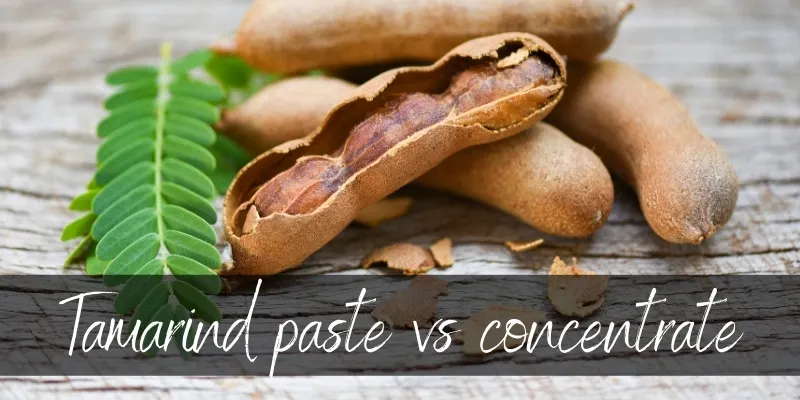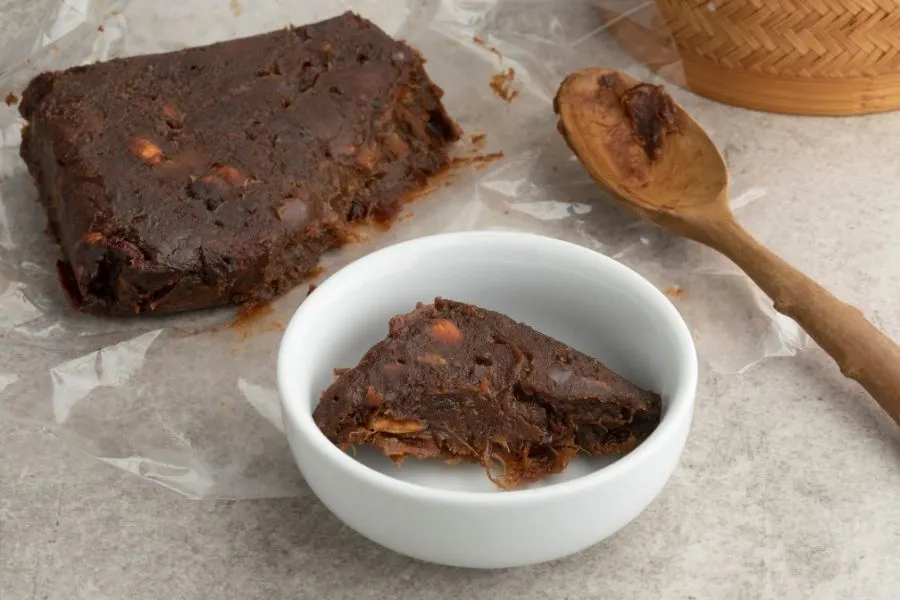A hardwood fruit tree native to Africa, the tamarind tree now grows throughout Asia and Mexico. The tree yields large brown pods that contain the tamarind fruit.
Its pure form with the shell, tamarind, comes in three different forms – paste, pulp, and a thick, dark concentrate. People often confuse the concentrate and paste, but knowing the different types will help you decide which to use when.

Tamarind paste vs concentrate
The main difference between tamarind paste and concentrate is that the paste usually tastes much stronger, and comes directly from the fruit. The tamarind fruit sports a date-like texture and yields a tamarind paste, or a very diluted concentrate when crushed.
The concentrate usually comes from India and is quite dark in color, accompanied by a thick gel-like consistency.
Tamarind paste is the fruit pulp with the fibers and seeds removed. It comes in glass jars, or put in plastic squeeze tubes. The fact that it doesn’t contain seeds makes it much smoother, and it doesn’t call for soaking.
Do they come in different flavors ?
Depending on the brand and quality, the concentrate or paste may contain artificial sweeteners or preservatives. The taste of tamarind ranges from a relishing sweet and sour to a blend of tangy and tart.
The flavor often varies with the other ingredients the paste or concentrate is mixed with. For instance, adding some sugar can take the edge off of tamarind’s sour element. The other factor that alters the taste is how ripe the tamarind fruit was, specially when you make the paste at home. The less ripe the fruit, the sourer the flavor – it gets sweeter as the fruit matures and ripens.
Generally, tamarind concentrate and paste feature a somewhat sweet flavor that comes with acidity like lemon juice. Some say that going for some homemade paste prepared from soaking and straining a block of tamarind pulp yields the best taste. Not only is it less processed, but also tastes so much more fresh than a packed purchase.
Read also: Best Tamarind Substitutes
Can you substitute tamarind paste for concentrate ?
Yes, you can substitute tamarind paste for concentrate, or the other way around. Tamarind concentrate and paste are readily available in most markets, especially Asian stores. You can always use them as a substitute for each other if one isn’t available. Sometimes, regular tamarind paste is also labeled as a concentrate.
The fact that they taste quite the same makes them the same product in terms of the application. Both are thick and smooth but can easily be spooned. However, the form that’s more convenient to freeze is the paste.
Tamarind concentrate is a bit easier to use as compared to the paste. If you want to substitute paste with concentrate, simply reconstitute the thick concentrate with some water. Go for double the amount of water as the concentrate, further stirring it well.
Measure and you can use the mix in any recipe that requires you to add some tamarind paste. If a dish mentions 3 tablespoons of paste, simply mix one tablespoon of concentrate and 2 tablespoons of water to get it done.
If you can’t find both, you can go for equal quantities of dark brown sugar and lime juice combined together to work up as a substitute for the concentrate or the paste. Although this may not always give you the exact complexity in terms of the taste, this mix will surely bring out a sweet and sour touch to the dish.
Is tamarind paste the same as tamarind pulp?
The fruit of tamarind contains a lot of seeds and pith. A specific type of tamarind product sold in the form of blocks is generally called tamarind pulp. The pulp is prepared from the whole fruits after they are skinned.
Tamarind paste is a processed form of the pulp. When all the fibers and seeds are removed by soaking tamarind pulp in boiling water, further rubbing it through a strainer or sieve – the process yields a fine paste. Both of them are quite interchangeable.

You can also turn the pulp into tamarind paste by using equal quantities of boiling water and the fruit pulp from the block. Soak the pulp i water for about 15 minutes, followed by stirring the mixture using a fork until you get a uniform consistency.
The idea is to extract the juice and paste by pouring the mixture into a fine strainer and pressing on the solids. The end results are a smooth paste that you can use in all the recipes that call for tamarind. Throw away the seeds and fiber.
You can prepare the large batches of paste with the pulp using this method as it can easily be frozen in small forms that are more convenient to use. Ice cube trays may come handy to get this done.
Read Also:Pomelo VS Yuzu
Using tamarind paste and concentrate
Whether concentrate or paste, tamarind is quite easy to use straight from the jar or tube. Because of the unique sour taste, you will need some sugar or another sweetener in most recipes you make with tamarind. The fact that tamarind brings out a amazing sweet and sour yet subtle flavor to a dish makes it quite popular as an ingredient.
Tamarind is used in various dishes in Southeast Asia, India, and the Middle East, including soups, sauces, curries, stir fries, noodle dishes and desserts. Apart from that, it’s also the element that makes Worcestershire sauce pleasantly sour.
How much of the paste or concentrate you add to a dish depends on the brand you use as it determines the strength and thickness of the mix. If the paste seems a bit runny, add a little more to get the desired flavor.
Tamarind can be mixed into chutneys and uncooked dips, added to marinades for its acidic touch, making the meat so much more tender.
Tamarind paste is also found in recipes for desserts and candies. Indian chutneys usually go for tamarind concentrate, while the paste goes for sweets and several desserts.

